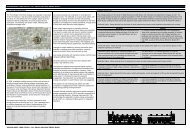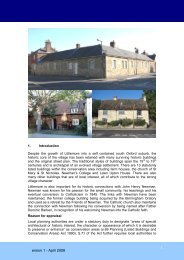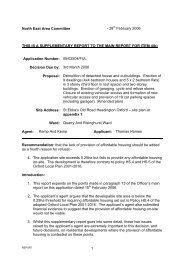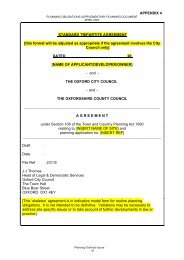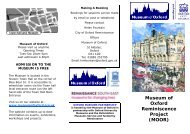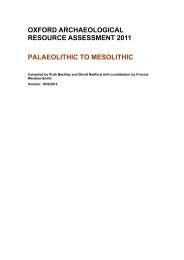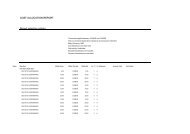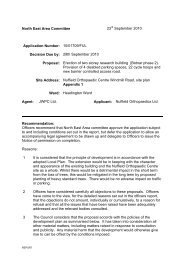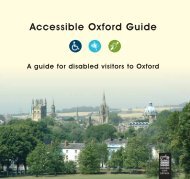Post-medieval Oxford - Oxford City Council
Post-medieval Oxford - Oxford City Council
Post-medieval Oxford - Oxford City Council
You also want an ePaper? Increase the reach of your titles
YUMPU automatically turns print PDFs into web optimized ePapers that Google loves.
stamps denoting quality control) and could have come from hide used for saddle<br />
making, probably in the 16 th or 17 th century (Egan 1979: 101).<br />
A guild of mercers and woollendrapers was recorded in the late 16 th century and<br />
continued to function within the town until it was dissolved in 1855 (VCH iv: 320). The<br />
university’s hold over the guilds was challenged without success on several<br />
occasions by the city. In 1556 and 1571, the city attempted to incorporate an<br />
independent brewers guild, squashed by the university in 1575 (ibid.: 321). On<br />
several occasions during the 16 th century, the city attempted to remove university<br />
control over the bakers with little success (ibid.: 322). By the end of the 17 th century,<br />
the bakers had ceased to function as a guild even as controlled by the university. An<br />
attempt by the city to gain control over the tailors’ guild in 1516 failed; however by<br />
1571 the city had successfully gained control.<br />
The Old Bank<br />
The Old Bank at 92-3 High Street was the earliest bank in <strong>Oxford</strong> originating in 1775.<br />
The buildings date to the late 18th century, No 92 from 1775 and No 93 in 1798 (the<br />
former was of stone and the later timber-frame clad in stone). The bank was taken<br />
over in 1900 by Barclays Bank which remodelled the building c.1903 along with the<br />
front of No 94 in 1931 (VCH iv). No 94 High Street and No 1 Magpie Lane are of<br />
earlier date - 16 th to 17 th century (RCHM 1939). Remains of earlier buildings on the<br />
site have been recorded during a building survey in 1998 (Newell and Munby 2000).<br />
The conversion to a hotel took place in 1998-9.<br />
Coffee houses<br />
<strong>Oxford</strong>s first coffee house opened in 1651 at No 85 High Street; a plaque in the<br />
current coffee house commemorates this event (Mellor 1997: 70). A number of<br />
establishments followed, and the history of over 50 locations has been traced<br />
(Aubertin-Potter and Bennett 1987).<br />
Mills and mill sites<br />
Many of <strong>Oxford</strong>’s historic mills (e.g. Castle Mill and King’s Mill) remained in continual<br />
use throughout the period, while some appeared on new sites. The Greyfriars mill is<br />
recorded between 1668 and 1732 on the site of the Greyfriars Precinct, possibly<br />
associated with a brewhouse (VCH iv: 329). A back-filled mill race and demolition<br />
debris of 16 th -17 th century date, perhaps from the <strong>medieval</strong> Greyfriars Mill, was<br />
recorded during evaluation trenching at Westgate Car Park in 2008 (Bashford 2008).<br />
The site of the post-<strong>medieval</strong> mill remains unclear.<br />
A mill briefly operated on the site of the former Rewley Abbey, set up in 1555. No<br />
later record of it beyond 1557 survives (VCH iv: 330). Holywell Mill was held by<br />
Merton College throughout the post-<strong>medieval</strong> period until it was sold in 1877 (Bell<br />
1996: 2). De Gomme’s map of the Civil War defences in 1644 indicate the mill was<br />
surrounded by a bastion and a slight earthwork east of the mill may have formed part<br />
of these defences (ibid.). Documentary evidence also indicates the manor of Holywell<br />
was included within the Civil War defences at the expense of the College which was<br />
required by the King to either pay for the defences or demolish the structures (Munby<br />
in Bell 1996: 291). Archaeological investigations at Holywell Mill in 1993 identified<br />
several possible <strong>medieval</strong> buildings to the north of the mill and a large curving ditch<br />
that may represent the Civil War defences (Bell 1996: 275). The infilling of the ditch<br />
could not be reliably dated, however, the mid-fill contained late 17 th century pottery<br />
suggesting if this was the defences it was short lived (Munby in Bell 1996: 294).<br />
The leat of Lower Wolvercote paper mill was identified in an evaluation in 2006; it<br />
had been back-filled in the 19 th century (Mumford 2006). A mill on Old Abingdon<br />
Road, known as Langford Mill, Hinksey Mill, New Hinksey Mill and Towles Mill<br />
OXFORD ARCHAEOLOGICAL RESOURCE ASSESSMENT- POST MEDIEVAL<br />
33



